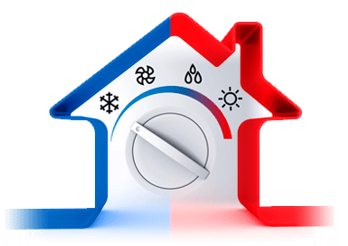建筑暖通空调图纸符号
暖通空调:供暖通风和空调 (HVAC: Heating Ventilation and Air Conditioning)
HVAC is an abbreviation of Heating Ventilation and Air Conditioning. It is a sequence of orders of technologies mostly used to manage room temperature, humidity, and Airflow within a defined region. It is developed to make available for use thermal comfort and acceptable indoor air standard. In mechanical engineering, the HVAC system design is the subject. It is worked based on the fundamentals of thermodynamics, fluid mechanics, and heat transfer. For both domestic and commercial buildings, HVAC systems can be used. It consists of central air conditioning, heating, and ventilation system.
HVAC是供暖通风和空调的缩写 。 它是一系列技术订单,主要用于管理定义区域内的室温,湿度和气流。 它的开发旨在提供使用舒适性和可接受的室内空气标准。 在机械工程中,HVAC系统设计是主题。 它是基于热力学,流体力学和热传递的基本原理进行工作的。 对于家用和商用建筑,都可以使用HVAC系统。 它由中央空调,供暖和通风系统组成。

基本HVAC零件 (Fundamental HVAC Parts)
Furnace
炉
Heat Exchanger
热交换器
Evaporator Coil
蒸发器盘管
Condensing Unit
冷凝机组
Refrigerant Lines
制冷剂管线
Thermostat
温控器
Ducts
风管
Vents
通风Kong
用法 (Usage)
To design and develop well-furnished and extremely comfortable or elegant surroundings within a building or in vehicles, HVAC technology is used which is very fundamental and significant in the creation of methods to large industrial and office buildings. The primary example of this technology in use is Vehicles, Restaurants, Schools and Colleges, Business Offices, Hotels, Shopping Malls, etc.
为了在建筑物或车辆中设计和开发布置精美,极其舒适或优雅的环境,使用了HVAC技术,这对于创建大型工业和办公建筑物的方法非常重要且意义重大。 使用该技术的主要示例是车辆,饭店,学校和学院,营业所,酒店,购物中心等。
Its chief aim is to make available for use thermal comfort, proper ventilation to abolish displeasing smell and non-essential moisture within the sensible installation, operational and maintenance costs.
其主要目的是在合理的安装,运营和维护成本内提供热舒适性,适当的通风以消除令人不快的气味和不必要的水分。
历史 (History)
HVAC is a set of the order of technologies. It is worked based on the inventions of some famous scientists like Nikolay Lvov, Michael Faraday, Willis Carrier, Reuben Trane, James Joule, William Rankine, Sadi Carnot, and lots of others.
暖通空调是一组技术顺序。 它是基于一些著名科学家的发明而建立的,例如Nikolay Lvov,Michael Faraday,Willis Carrier,Reuben Trane,James Joule,William Rankine,Sadi Carnot和许多其他人的发明。
优点 (Advantages)
It can reduce the risk of water loss and dehydration and also they can be obliging in preventing heat strokes.
它可以减少水分流失和脱水的风险,并且它们也可以防止中暑。
It enhances air standard inside the building and creates a much healthier surrounding. It can filter out pollen, dust, and other allergens available in the surrounding.
它提高了建筑物内的空气质量,并创造了更健康的环境。 它可以过滤掉周围的花粉,灰尘和其他过敏原。
In one unit, both heating and cooling consist of the HVAC system. This solitary saves construction space, installation time and fees, and power usage which is needed.
在一个单元中,加热和冷却都由HVAC系统组成。 这样可以节省建筑空间,安装时间和费用,以及所需的功率消耗。
缺点 (Disadvantages)
It can make a user skin loses its moisture, as a result of that becoming sensitive and dry. It can also make the annoyance happen and dryness of the mucous membrane.
由于变得敏感和干燥,它会使使用者的皮肤失去水分。 它也可以使烦恼和粘膜干燥。
An immediate change in temperature has been shown to aggravate the symptoms of numerous respiratory diseases.
已经表明,温度的即时变化会加剧许多呼吸道疾病的症状。
Not cleaning the HVAC system can make happen the buildup of dust, bacteria, and pollen in the air filters. This will remarkably increase the risk of asthma attacks and respiratory tract infections.
不清洁HVAC系统会导致空气过滤器中积聚灰尘,细菌和花粉。 这将显着增加哮喘发作和呼吸道感染的风险。
翻译自: https://www.includehelp.com/dictionary/hvac-full-form.aspx
建筑暖通空调图纸符号







 本文深入解析HVAC(供暖通风和空调)系统,介绍其组成部分如炉子、热交换器、蒸发器盘管等,以及在建筑和车辆中创造舒适环境的应用。HVAC技术基于热力学、流体力学和热传递原理,旨在提供热舒适性、适当通风和室内空气质量。
本文深入解析HVAC(供暖通风和空调)系统,介绍其组成部分如炉子、热交换器、蒸发器盘管等,以及在建筑和车辆中创造舒适环境的应用。HVAC技术基于热力学、流体力学和热传递原理,旨在提供热舒适性、适当通风和室内空气质量。

















 被折叠的 条评论
为什么被折叠?
被折叠的 条评论
为什么被折叠?








